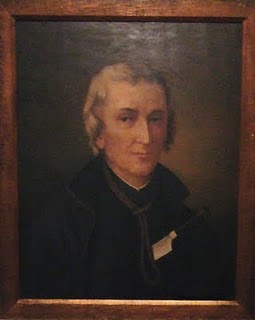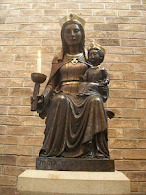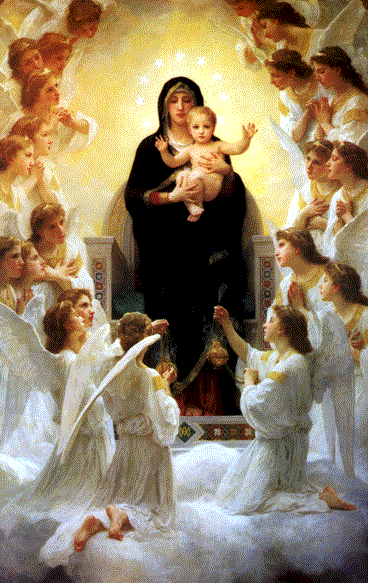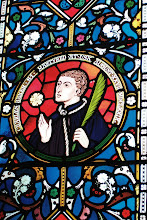Fr Ignatius Price was born in Monmouthshire in 1610. Based at the Jesuit College of St Francis Xavier at the Cwm and working under the alias of Walter Price or Harries, he served the Jesuit Welsh Mission from 1644 until his death in 1679. Because of the tolerance of many of the Monmouthshire magistrates and officials, who turned a blind eye to the practise of the Old Faith, the diligence and hard work of the priests based at the Cwm was very productive.
However, there were those, notably John Arnold, a Justice of the Peace and Member of Parliament for Monmouthshire, Charles Price of Llanfoist and John Scudamore of Kentchurch, who were less than happy with their fellow magistrates and officials. In 1670 they informed the House of Lords that “there were still six priests living at the Cwm, a place which had been a centre for nearly forty years.” In 1674, as a result of such reports, Parliament ordered the arrest of the priests who lived at the Cwm and threatened to punish all Catholics with the immediate seizure of two-thirds of their lands. Thanks to the support amongst local magistrates, some of whom had Catholic relatives and friends, these orders were not obeyed and nothing was done.
Early in 1678, Arnold and Price presented the House of Commons with a printed document named an “Abstract of Examinations”. Arnold and Price were unflagging in their efforts to have the anti-Catholic Laws enforced and this document gave an account of the work of the Church as seen by the informers. By that time, Parliament had grown increasingly alarmed by its inability to root out and destroy the Old Faith and its apparent growth and revival in Monmouthshire and Hereford. There was also much talk of dark plots. In this atmosphere, Titus Oates, bolstered by the support of Chepstow born William Bedloe, had little trouble spreading his poisonous fabrication, “The Popish Plot”. The effects of this evil hoax spread into Monmouthshire about October 1678.
Fr David Lewis was Rector of the Cwm from 1667-1672 and again from 1674 until its sacking in 1679. Fr Lewis, realising the danger of their situation, quickly evacuated the Cwm. The priests were scattered. A few found shelter with courageous Catholic families but most of them were forced, in harsh winter weather, to hide in woods and cave, wherever shelter could be found. Fr Ignatius Price was one who took to the hills and died, harried and hunted like an animal! Fr Lewis and Fr Ignatius Price were friends as well as colleagues and Fr Lewis referred to Fr Price as his “very good friend”.
Fr David Lewis had been arrested on 17th November 1678 and incarcerated in Monmouth Gaol. On 13th January 1679, in atrocious weather and under guard, he was transferred to the new County Gaol at Usk. On the way, the group stopped at an Inn in Raglan for a brief respite from the cold and snow. While there Fr Lewis received a heartbreaking message. Fr Lewis wrote:
“Whilst I was in Raglan, a messenger came to the door of the inn, desiring to speak with me on urgent business. A very good friend of mine, one Mr Ignatius alias Walter Price, lay dying about half a mile away. He had undergone much hardship from hunger and cold and lay dying. He desired to see me. But I was quite unable to perform the friendly duty, as I was under the actual custody of the officers. So I only sent him my true and best wishes for his soul’s happy passage out of this turbulent world to an eternity of rest.”
Three days later Fr Price died.
However, there were those, notably John Arnold, a Justice of the Peace and Member of Parliament for Monmouthshire, Charles Price of Llanfoist and John Scudamore of Kentchurch, who were less than happy with their fellow magistrates and officials. In 1670 they informed the House of Lords that “there were still six priests living at the Cwm, a place which had been a centre for nearly forty years.” In 1674, as a result of such reports, Parliament ordered the arrest of the priests who lived at the Cwm and threatened to punish all Catholics with the immediate seizure of two-thirds of their lands. Thanks to the support amongst local magistrates, some of whom had Catholic relatives and friends, these orders were not obeyed and nothing was done.
Early in 1678, Arnold and Price presented the House of Commons with a printed document named an “Abstract of Examinations”. Arnold and Price were unflagging in their efforts to have the anti-Catholic Laws enforced and this document gave an account of the work of the Church as seen by the informers. By that time, Parliament had grown increasingly alarmed by its inability to root out and destroy the Old Faith and its apparent growth and revival in Monmouthshire and Hereford. There was also much talk of dark plots. In this atmosphere, Titus Oates, bolstered by the support of Chepstow born William Bedloe, had little trouble spreading his poisonous fabrication, “The Popish Plot”. The effects of this evil hoax spread into Monmouthshire about October 1678.
Fr David Lewis was Rector of the Cwm from 1667-1672 and again from 1674 until its sacking in 1679. Fr Lewis, realising the danger of their situation, quickly evacuated the Cwm. The priests were scattered. A few found shelter with courageous Catholic families but most of them were forced, in harsh winter weather, to hide in woods and cave, wherever shelter could be found. Fr Ignatius Price was one who took to the hills and died, harried and hunted like an animal! Fr Lewis and Fr Ignatius Price were friends as well as colleagues and Fr Lewis referred to Fr Price as his “very good friend”.
Fr David Lewis had been arrested on 17th November 1678 and incarcerated in Monmouth Gaol. On 13th January 1679, in atrocious weather and under guard, he was transferred to the new County Gaol at Usk. On the way, the group stopped at an Inn in Raglan for a brief respite from the cold and snow. While there Fr Lewis received a heartbreaking message. Fr Lewis wrote:
“Whilst I was in Raglan, a messenger came to the door of the inn, desiring to speak with me on urgent business. A very good friend of mine, one Mr Ignatius alias Walter Price, lay dying about half a mile away. He had undergone much hardship from hunger and cold and lay dying. He desired to see me. But I was quite unable to perform the friendly duty, as I was under the actual custody of the officers. So I only sent him my true and best wishes for his soul’s happy passage out of this turbulent world to an eternity of rest.”
Three days later Fr Price died.

Based on a firsthand account, Brother Henry Foley gives us a vivid and harrowing description of the last days of Fr Ignatius Price.
“For nearly two months in the depths of winter, scarcely a night passed in which he was not sought for in the houses of Catholics, flying from cottage to cottage, sometimes barefoot through heavy snow and deep water, clad for the most part in linen, the aged priest had no place that could offer him any real shelter. Catholics even, through fear of the terrible laws, sometimes denied him hospitality, while he avoided their houses lest he involve his host in the punishment of death for harbouring a Jesuit. In order to avoid the snares laid for him, Fr Price had been compelled to fly by night ‘from barn to barn, from cave to cave, even from hogsty to hogsty'. At length, he contracted a violent fever from which he soon died.”
It is believed that his relative, Charles Price of Llanfoist, the venomous collaborator of John Arnold, was responsible for this relentless pursuit of Fr Ignatius Price. There are even reports that, upon discovering the Jesuit’s grave, he had it opened so that he could remove a cross which had been buried with the priest. It was said that, given the man’s avaricious nature, this was not for love of the cross but for love of the metal!
So died Fr Ignatius Price S J, another brave and selfless priest. Although never brought to trial and not executed on the gallows, Fr Price was another innocent victim of the evil Titus Oates, his fellow liars, the non-existent Popish Plot, the bigoted Arnold, the rapacious Price, and their ilk.
(I think that I should say a special "Thank You" to my long-suffering husband. I wanted a winter photo to go with this post and I didn't have one that I considered appropriate. I didn't want a pretty winter scene or a happy one. It had to be one that conveyed a sense of the cold and dark conditions under which Fr Ignatius Price spent his last months. So, my dear husband, shortly after midnight and with snow still falling, opened our bedroom window and took a couple of photographs! The above photo is one of them and I think it is very apt as well as starkly beautiful. So - "Thank You", long-suffering husband!)








.JPG)

.JPG)





The long suffering that these true men of God went through amazes me and challenges me as well.
ReplyDeleteFor their incredible faith I give thanks.
The picture your husband took from your window is perfect. Excellent accompaniment to the story.
Thank you!
Good Morning Daily Grace
ReplyDeleteYes, I agree with you. These priests were men of great faith and an inspiration to us all. Glad you approve of the photo and my husband thanks you too. Thanks for your support. God bless you.
To Andrew McNabb
ReplyDeleteI am very sorry Andrew, but I don't do adverts! However, I wish you much success with your book both in the U K as well as in the U S. God bless you.